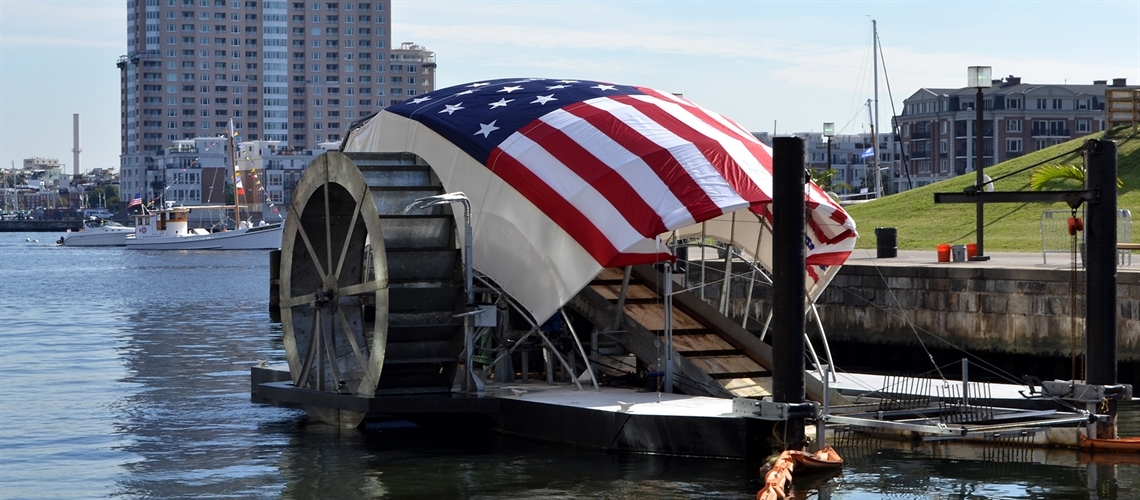Inviting
2040 Goal: Fully litter- and odor-free rivers

Steve Earley
This automated device, nicknamed "Mr. Trash Wheel," collects litter in Baltimore's harbor. Automated devices like this could supplement and expand the coverage of the skimmer boats MWRD already operates on our rivers.
Increased and coordinated litter removal and odor management will greatly improve the cleanliness and aesthetics of Chicago’s rivers, and as a result, people will flock to them.
As scheduled stormwater management investments are developed, fewer and fewer overflows into our rivers will occur, reducing litter loads. Once in the water, skimmer boats and innovative, automated instream technologies will play an increasing role. In addition, increased street sweeping and more garbage and recycling receptacles on land adjacent to the rivers will lead to significant improvement, because most river litter is blown by the wind from streets and sidewalks.
A public awareness campaign will teach residents and visitors that litter often ends up in the river. Storm drains and signs will be brightly painted to help people make the connection between street litter, oil and trash in the rivers. Litter clean-ups should occur more frequently throughout the year and at more sites, including along the Des Plaines River. By teaching people about the connection between litter and our rivers and by providing them with more opportunities to be stewards of our rivers, we will forge a deeper sense of shared responsibility in metropolitan Chicago for keeping our rivers clean. By 2030, litter in our rivers will be largely a thing of the past.
63% of focus group members reported litter or odor
Odor improvements will occur over a longer time frame, and are the culmination of new investments in infrastructure, enhancements in wastewater treatment and stormwater management, and instream remediation. We will install additional aeration stations on marginal riverfront parcels, which would have the added benefit of creating visually engaging falling water installations. Nutrient pollution, which feeds smelly algae, will be reduced through improved wastewater management and nature-based stormwater infrastructure. In priority locations, such as Bubbly Creek and the Collateral Channel, we will have demonstrably improved odor problems through a combination of techniques, such as instream and sidestream aeration stations, capping or removing problem sediments and increasing water flow. Innovative in-pipe treatment technologies installed at priority combined sewer outfalls will further reduce litter and other pollution to the rivers, especially at points that once discharged high volumes on a regular basis.

Ryan Griffin–Stegink
Sidestream elevated pool aeration stations, like this one on the Calumet River, are an attractive way to reduce odor and improve water quality.
Making it happen
- Determine costs and opportunities for more skimmer boats, staged at locations throughout the river system, and for using a variety of technologies to best handle the varied conditions of the rivers and shorelines.
- Assess the feasibility of and construct instream litter collection devices to filter litter out of river water, combined sewer overflow pipes and side bays.
- Assess the feasibility of and construct additional sidestream or instream aeration stations to restore oxygen to the water.
- Develop a schedule for preventative street sweeping in advance of major storms.
- Increase the number of garbage and recycling cans adjacent to riverfront locations.
- Develop a public awareness campaign to reduce litter.
- Prioritize sites with strong odor problems and develop remediation plans for each, including pollutant controls and aeration, if needed.
- Expand riverfront clean-up events to include all three of Chicago’s rivers, and develop a robust “Adopt-a-Mile” program to expand stewardship program participation.
- Expand household hazardous waste collection days and drop-off locations for expired or unused pharmaceuticals.
Key players
Chicago Dept. of Streets and Sanitation, MWRD, Chicago Dept. of Water Management, U.S. Army Corps of Engineers, Cook County, Friends of the Chicago River, community organizations, riverfront property owners
Our rivers, our role
- Sign up for Chicago River Day and other clean-ups, ideally adding new sites to the mix throughout the year.
- Report noxious odors, litter and other issues to your alderman, the City (call 311) and MWRD on the web.
- Participate in hazardous waste collection days and pharmaceutical drop offs, and help spread the word about both.
Back to goals